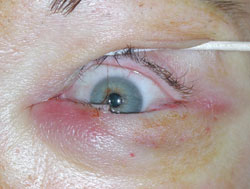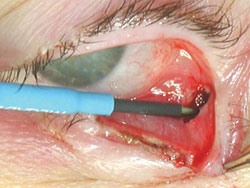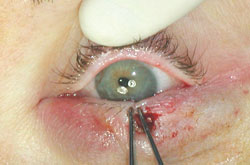Internal cantholysis a powerful new technique to close eyelid defects
The procedure increases eyelid mobility and minimizes the postoperative tenderness associated with external lateral canthotomy and cantholysis.
 Thomas John |
Surgical repair of eyelid defects aims to restore the normal cosmetic appearance of the eyelids without compromising the functionality of the involved structures. This goal may be difficult to attain when there is tissue loss and primary surgical wound approximation and closure is not possible without compromising the cosmetic appearance and functionality of the involved eyelids. In such instances, cantholysis helps to mobilize the eyelids and achieve optimal wound closure in most cases. An external approach of lateral canthotomy and cantholysis is associated with an external wound and local tissue tenderness. Various flap techniques have been described in the ophthalmic literature. However, moving from an external to an internal transconjunctival approach will usually produce a better cosmetic result without a visible external wound.
In this column, Drs. Perry and Lewis describe their new surgical technique of internal cantholysis via a transconjunctival route that provides eyelid mobility of roughly 4 mm to over 1 cm, facilitating surgical repair of full-thickness eyelid defects.
–Thomas John, MD
OSN Surgical Maneuvers
Editor
 Julian D. Perry |
Closure of larger full-thickness eyelid defects often requires an external canthotomy and cantholysis, a rotational flap, or even a shared flap from the upper eyelid. In order to minimize operative morbidity for closure of such defects, we have developed a new technique that we term internal cantholysis.
This conjunctival-approach lysis of the lateral canthal tendon effectively increases eyelid mobility to avoid more invasive repair methods. We have used this technique to assist with closure of full-thickness eyelid defects for the past 2 years, and it has become our first option when simple direct closure is not possible.
Treating eyelid defects
We initially developed this technique to treat eyelid defects that could not quite be closed primarily without undue wound tension. To avoid the additional skin incision and postoperative tenderness associated with external lateral canthotomy and cantholysis, we tried lysing the few fibrous bands that compose the inferior crus of the lateral canthal tendon through a conjunctival approach, and it worked like a charm. At a minimum, internal cantholysis provides an additional 4 mm to 6 mm of eyelid mobility, often the difference between excessive wound tension and easy closure.
We published our initial experience with this technique recently in Ophthalmic Plastic and Reconstructive Surgery. Our initial report included 12 patients with small- to moderate-sized defects, up to 20 mm. We found that patients tolerated the internal cantholysis very well, and that eyelids healed without notching or wound dehiscence.
Evolution of technique
Our technique has evolved slightly since our first report. We initially created a conjunctival incision to access the fibrous bands that compose the lateral canthal tendon. Through this conjunctival incision, we located these fibrous bands with a strumming motion of the electrocautery tip, then lysed the bands using cutting electrocautery. After becoming more familiar with the technique, we found that the first conjunctival incision was not necessary.
 Full-thickness eyelid defect. |
 Conjunctival incision and transconjunctival cantholysis. |
 Increased mobility allows apposition without undue wound tension. |
 Defect closed. Images: Perry JD |
Our current technique is as follows: While holding the free eyelid on stretch, we probe the crus of the lateral canthal tendon with a strumming motion. After identifying a fibrous tether, we lyse the band with a short pulse of cutting electrocautery. We then find and sever the remaining bands through the resulting small conjunctival incision. You will notice a substantial give to the free eyelid when each band is cut. We have found that most eyelids contain three to six substantial bands. Internal cantholysis creates at least 4 mm of eyelid mobility and in some cases well over 1 cm. This technique, once a surgeon is familiar with it, adds approximately 2 minutes of surgical time.
Encouraged by our early results, we have used internal cantholysis successfully for increasingly larger eyelid defects, and in conjunction with other eyelid reconstruction techniques (Cutler-Beard, Hughes) requiring some additional eyelid mobilization. For larger defects (over two-thirds of the eyelid margin), we have released the entire lateral canthal tendon transconjunctivally. While these patients initially have substantial shortening of the horizontal palpebral fissure, we have found that the lateral canthal dystopia improves over time.
In summary, internal cantholysis quickly and effectively increases eyelid mobility. For these reasons, this technique has become our most common method of eyelid repair when direct closure is not possible. Once you try it, you will appreciate how easy it is to close medium-sized eyelid defects. We recommend that you add internal cantholysis to your armamentarium.
Reference:
- Lewis CD, Perry JD. Transconjunctival lateral cantholysis for closure of full-thickness eyelid defects. Ophthal Plast Reconstr Surg. 2009;25(6):469-471.
- Julian D. Perry, MD, can be reached at Division of Ophthalmology, Cole Eye Institute, 9500 Euclid Ave., Cleveland, OH 44195; 216-444-3635, fax: 216-445-8475; e-mail: perryj1@ccf.org. Supported in part by Research to Prevent Blindness.

